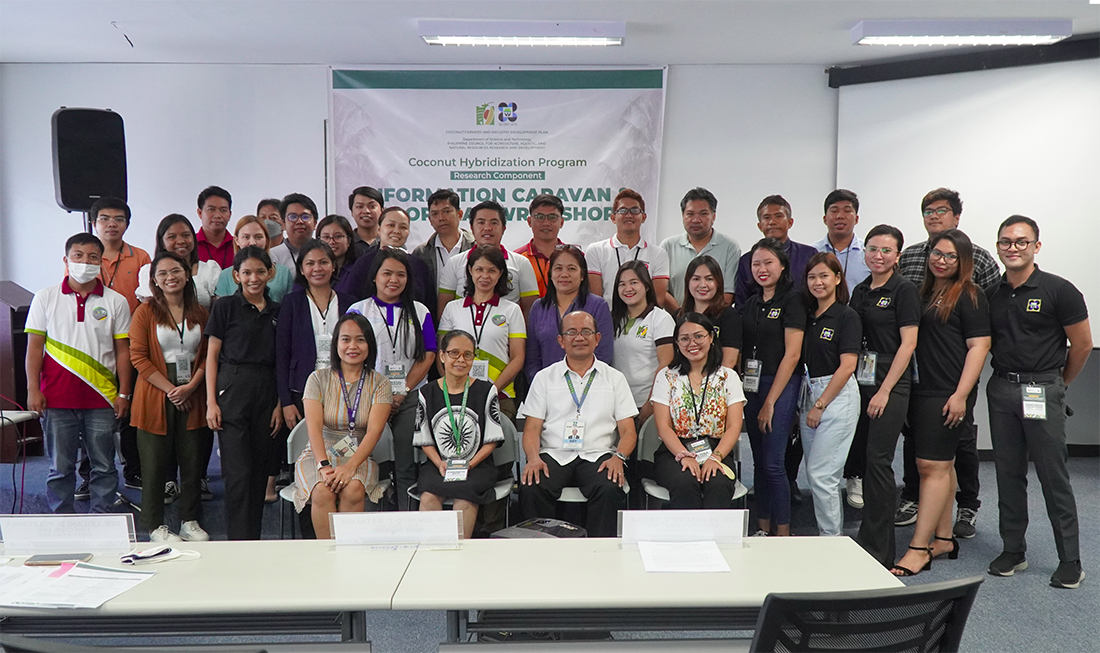Coconut hybrids with higher and better coconut oil content, copra yield, size, and resiliency are produced by crossing two coconut varieties with different and desirable traits.
With its superior qualities to regular coconut, coconut hybrids can boost coconut production and revitalize the coconut sector. However, research is needed to unlock the full potential of these hybrids and develop new ones that can further withstand climate, diseases, and insect pests.
To encourage more researchers and scientists to submit proposals focusing on coconut hybridization, the Philippine Council for Agriculture, Aquatic and Natural Resources Research and Development of the Department of Science and Technology (DOST-PCAARRD) has begun its regional information caravan and proposal writing workshop.

DOST-PCAARRD Executive Director Reynaldo V. Ebora while delivering his opening message during the CHP Information Caravan and Proposal Writeshop for Region IV and NCR. (Image credit: Crops Research Division, DOST-PCAARRD)
At the activity's kick-off, which took place recently in Los Banos, Laguna, DOST-PCAARRD Executive Director Dr. Reynaldo V. Ebora welcomed the participants, whom he addressed as potential implementing partners for Coconut Hybridization Program (CHP) and other related projects. He also urged them to conduct research not only to advance knowledge but improve both the livelihood of farmers and the coconut industry.
Conducted as part of the Coconut Farmers and Industry Development Plan (CFIDP) CHP Research Component, the information caravan disseminated information about the program and DOST-PCAARRD’s proposal submission guidelines, and identified region-specific industry gaps as a springboard for the proposed research initiatives.
During the activity, Industry Strategic S&T Program (ISP) Manager for Coconut, Ms. Alissa Carol M. Ibarra explained the rationale of the activity and introduced the participants to the CFIDP programs, specifically to CHP. Meanwhile, the Philippine Coconut Authority (PCA) Region IV Focal Person for CFIDP, Ms. Kristal L. Lanceta presented the situation of the coconut industry in Region IV and PCA Operations Branch (OB) Senior Science Research Specialist, Ms. Marianita Eroy gave some research recommendations.

DOST-PCAARRD Crops Research Division Director Leilani D. Pelegrina (left photo) and Science Research Specialists II Ms. Alissa Carol M. Ibarra and Ms. Ma. Cecilia S. Alaban (right photo) while answering participants’ queries during the writing workshop. (Image credit: Crops Research Division, DOST-PCAARRD)
In addition, representatives from the Crops Research Division (CRD) of DOST-PCAARRD guided the participants to CHP priority R&D areas and DOST-PCAARRD forms and guidelines.
At the end of the program, CRD Director, Ms. Leilani D. Pelegrina thanked the 26 coconut researchers and representatives from Research and Development Institutions (RDIs) and State Universities and Colleges (SUCs) in Region IV and NCR including PCA, Batangas State University (BatSU), Southern Luzon State University (SLSU), Western Philippines University (WPU), Marinduque State College (MSC), Romblon State University (RSU), Cavite State University (CavSU), and Office of the Provincial Agriculturist of Quezon - Research Division, for their active participation.

Philippine Coconut Authority (PCA) Region IV Focal Person for CFIDP Ms. Kristal L. Lanceta while presenting the situation of the coconut industry in Region 4 and PCA Operations Branch (OB) Senior Science Research Specialist Ms. Marianita Eroy sharing PCA’s research recommendations. (Image credit: Crops Research Division, DOST-PCAARRD)

